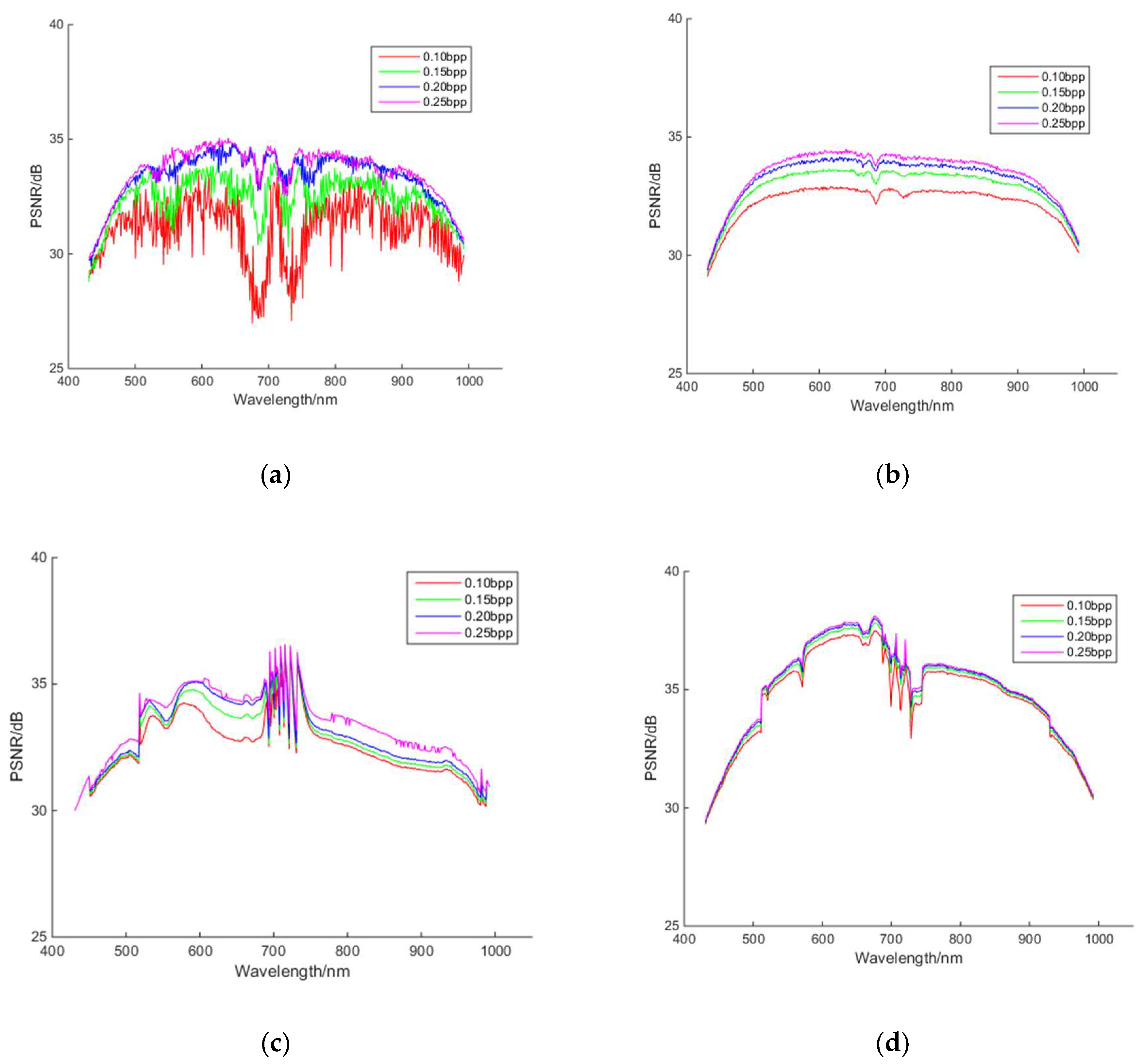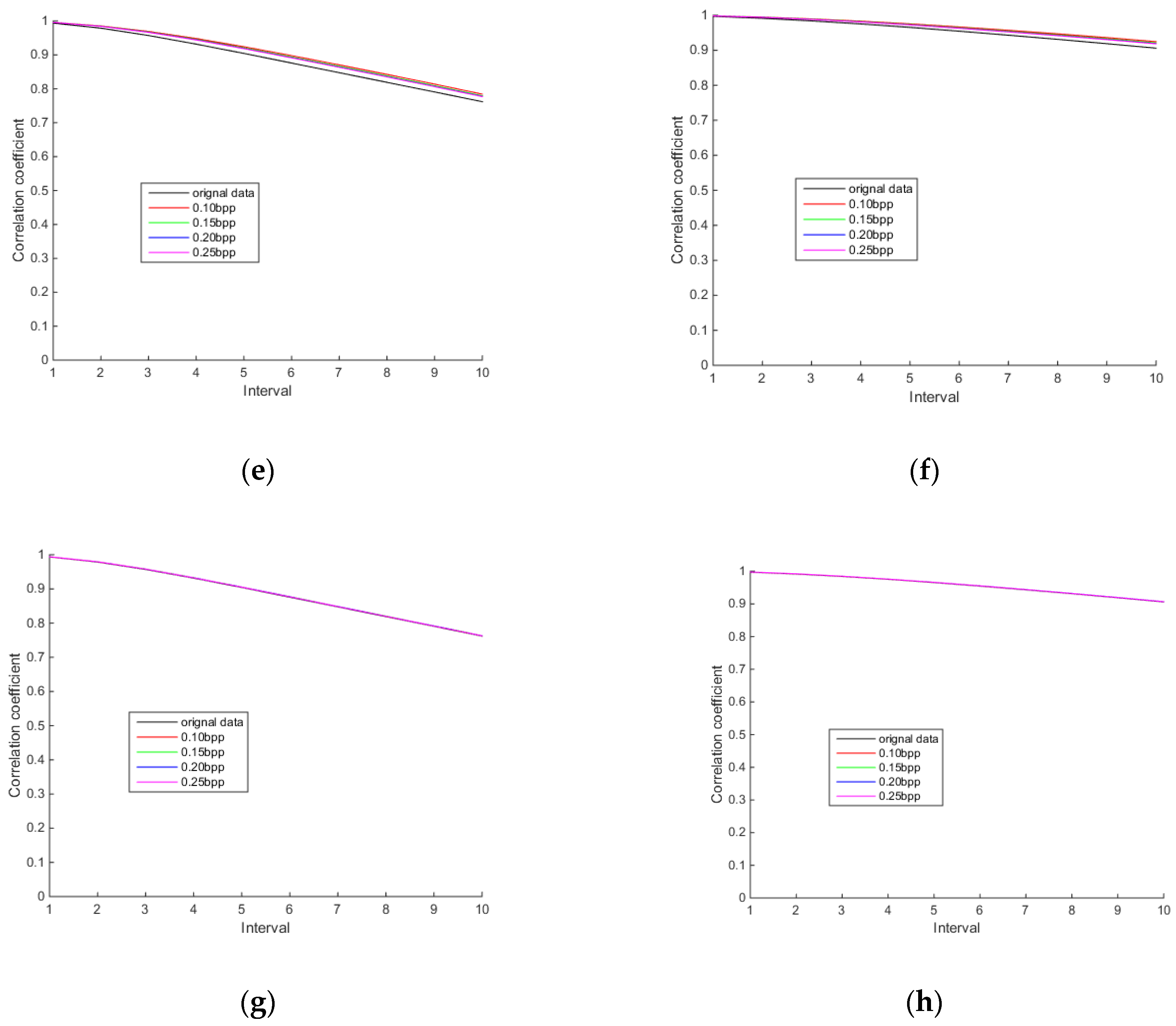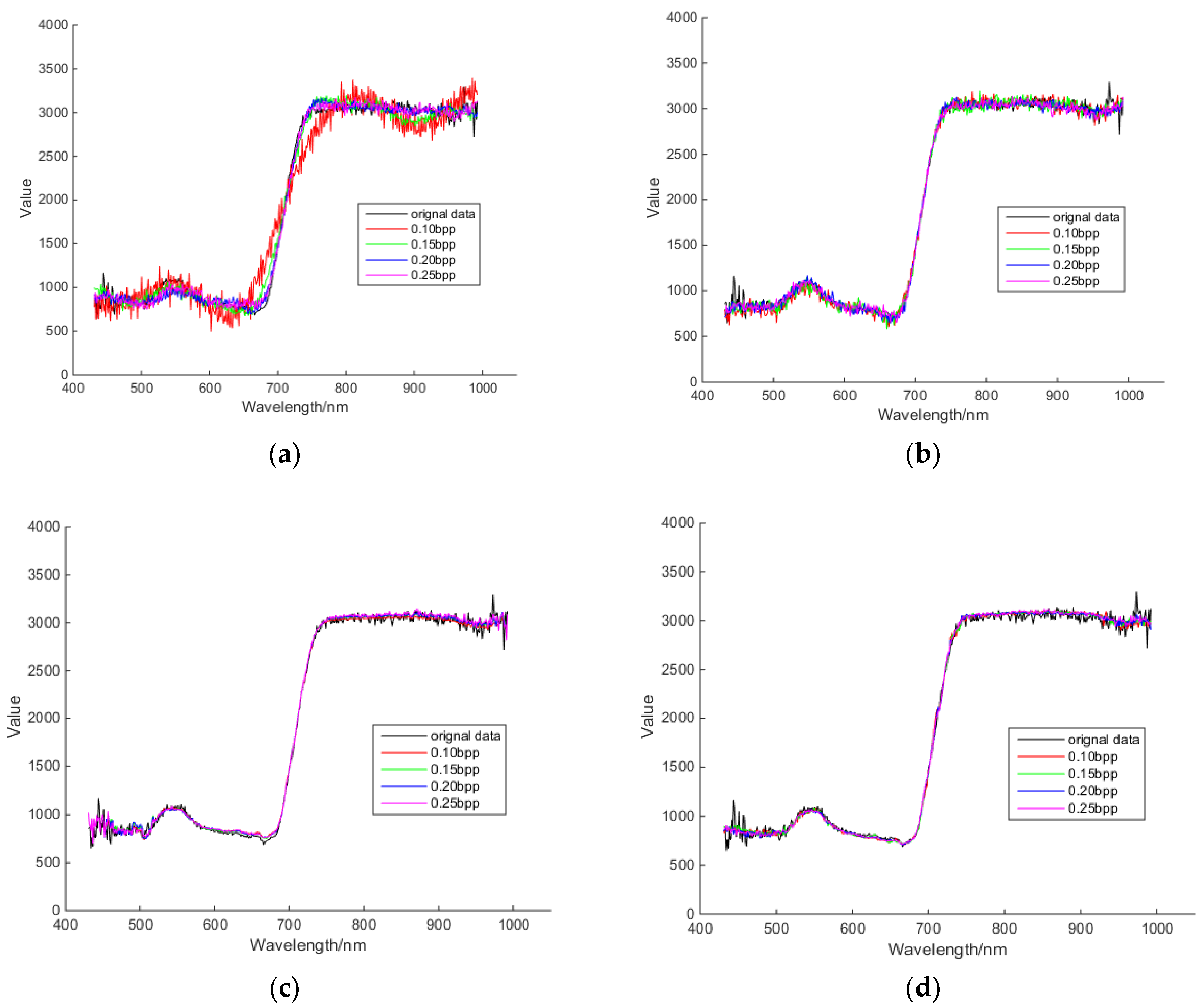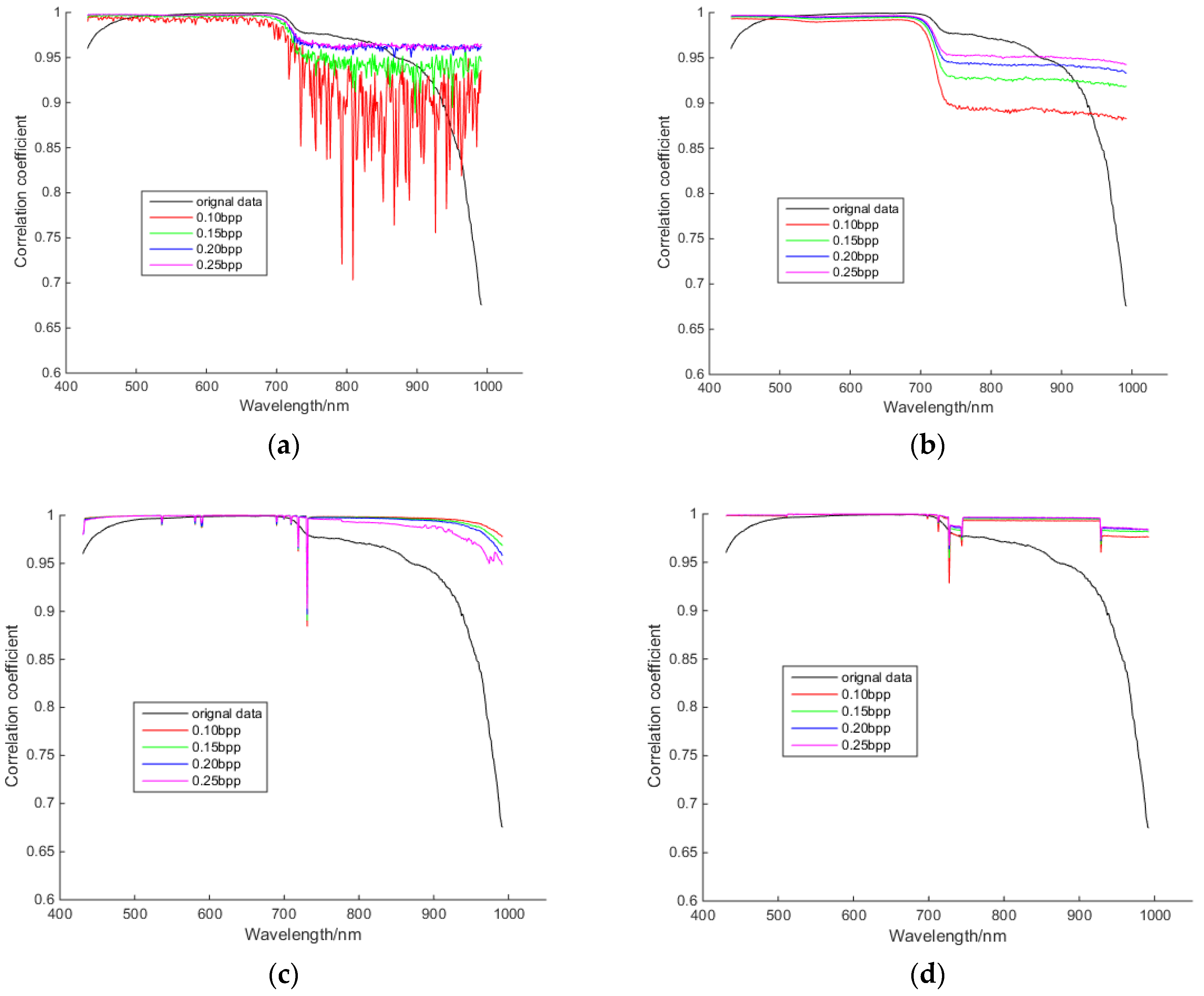A Prediction-Based Spatial-Spectral Adaptive Hyperspectral Compressive Sensing Algorithm
Abstract
:1. Introduction
2. Methods
2.1. PSSAHCS Algorithm
2.2. Adaptive Spatial Blocking
2.3. Adaptive Spectral Grouping
2.3.1. Adaptive Spectral Grouping Using k-Means Clustering Algorithm
2.3.2. LMLSD
2.3.3. Spectral Grouping Based on Linear Prediction
2.4. Stagewise Orthogonal Matching Pursuit Algorithm
2.5. The Evaluation Measures
2.5.1. PSNR
2.5.2. Interspectral Correlation
3. Experimental Results and Discussion
3.1. Data Description
3.2. Performance Evaluation in the Spatial Domain
3.2.1. Subjective Performance Comparison
3.2.2. The Peak Signal-to-Noise Ratio (PSNR) Performance Comparison
3.2.3. Comparison of Spatial Correlation
3.3. Comparison in the Spectral Domain
3.3.1. Comparison of Spectral Curve
3.3.2 Spectral Correlation Comparison
4. Conclusions
Author Contributions
Funding
Conflicts of Interest
References
- Li, R.; Sun, T.; Kelly, K.F.; Zhang, Y. A compressive sensing and unmixing scheme for hyperspectral data processing. IEEE Trans. Image Process. 2012, 21, 1200–1210. [Google Scholar] [PubMed]
- Zhang, L.; Wei, W.; Tian, C.; Li, F.; Zhang, Y. Exploring Structured Sparsity by a Reweighted Laplace Prior for Hyperspectral Compressive Sensing. IEEE Trans. Image Process. 2016, 25, 4974–4988. [Google Scholar] [CrossRef]
- Tohidi, E.; Radmard, M.; Majd, M.N.; Behroozi, H.; Nayebi, M.M. Compressive sensing MTI processing in distributed MIMO radars. IET Signal Process. 2018, 12, 327–334. [Google Scholar] [CrossRef]
- Donoho, D.L. Compressed sensing. IEEE Trans. Inf. Theory 2006, 52, 1289–1306. [Google Scholar] [CrossRef]
- Duarte, M.F.; Eldar, Y.C. Structured Compressed Sensing: From Theory to Applications. IEEE Trans. Signal Process. 2011, 59, 4053–4085. [Google Scholar] [CrossRef] [Green Version]
- Berger, C.R.; Wang, Z.; Huang, J.; Zhou, S. Application of compressive sensing to sparse channel estimation. IEEE Commun. Mag. 2010, 48, 164–174. [Google Scholar] [CrossRef]
- Huang, B.; Wan, J.; Xu, K.; Nian, Y. Block compressive sensing of hyperspectral images based on prediction error. In Proceedings of the 2015 4th International Conference on Computer Science and Network Technology (ICCSNT), Harbin, China, 19–20 December 2015; pp. 1395–1399. [Google Scholar]
- Zhang, L.; Wei, W.; Zhang, Y.; Shen, C.; Hengel, A.; Shi, Q. Dictionary Learning for Promoting Structured Sparsity in Hyperspectral Compressive Sensing. IEEE Trans. Geosci. Remote Sens. 2016, 54, 7223–7235. [Google Scholar] [CrossRef]
- Li, H.; Luo, H.; Yu, F.; Lu, Z. Reliable transmission of consultative committee for space data systems file delivery protocol in deep space communication. J. Syst. Eng. Electron. 2010, 21, 349–354. [Google Scholar] [CrossRef]
- Ghimire, B.; Bhattacharjee, S.; Ghosh, S.K. Analysis of Spatial Autocorrelation for Traffic Accident Data Based on Spatial Decision Tree. In Proceedings of the 2013 Fourth International Conference on Computing for Geospatial Research and Application, San Jose, CA, USA, 22–24 July 2013; pp. 111–115. [Google Scholar]
- Gao, F. Research on Nondestructive Prediction Compression Technique of Hyperspectral Image. Ph.D. Thesis, Jilin University, Changchun, China, 2016. [Google Scholar]
- Chiani, M. On the Probability That All Eigenvalues of Gaussian, Wishart, and Double Wishart Random Matrices Lie Within an Interval. IEEE Trans. Inf. Theory 2017, 63, 4521–4531. [Google Scholar] [CrossRef] [Green Version]
- Bai, H.; Wang, A.; Zhang, M. Compressive Sensing for DCT Image. In Proceedings of the 2010 International Conference on Computational Aspects of Social Networks, Taiyuan, China, 26–28 September 2010; pp. 378–381. [Google Scholar]
- Patsakis, C.; Aroukatos, N. A DCT Steganographic Classifier Based on Compressive Sensing. In Proceedings of the 2011 Seventh International Conference on Intelligent Information Hiding and Multimedia Signal Processing, Dalian, China, 14–16 October 2011; pp. 169–172. [Google Scholar]
- Donoho, D.L.; Tsaig, Y.; Drori, I.; Starck, J. Sparse Solution of Underdetermined Systems of Linear Equations by Stagewise Orthogonal Matching Pursuit. IEEE Trans. Inf. Theory 2012, 58, 1094–1121. [Google Scholar] [CrossRef]
- Lee, D. MIMO OFDM Channel Estimation via Block Stagewise Orthogonal Matching Pursuit. IEEE Commun. Lett. 2016, 20, 2115–2118. [Google Scholar] [CrossRef]
- Xu, P.; Liu, J.; Xue, L.; Zhang, J.; Qiu, B. Adaptive Grouping Distributed Compressive Sensing Reconstruction of Plant Hyperspectral Data. Sensors 2017, 17, 1322. [Google Scholar] [CrossRef] [PubMed]
- Sun, W.; Yang, G.; Du, B.; Zhang, L.; Zhang, L. A sparse and low-rank near-isometric linear embedding method for feature extraction in hyperspectral imagery classification. IEEE Trans. Geosci. Remote Sens. 2017, 55, 4032–4046. [Google Scholar] [CrossRef]
- Sun, W.; Yang, G.; Wu, K.; Li, W.; Zhang, D. Pure endmember extraction using robust kernel archetypoid analysis for hyperspectral imagery. ISPRS J. Photogramm. Remote Sens. 2017, 131, 147–159. [Google Scholar] [CrossRef]
- Sun, W.; Du, Q. Graph-Regularized Fast and Robust Principal Component Analysis for Hyperspectral Band Selection. IEEE Trans. Geosci. Remote Sens. 2018, 56, 3185–3195. [Google Scholar] [CrossRef]
- Xu, P.; Liu, J.; Chen, B.; Zhang, J.; Xue, L.; Zhu, L.; Qiu, B. Greedy compressive sensing and reconstruction of vegetation spectra for plant physiological and biochemical parameters inversion. Comput. Electron. Agric. 2018, 145, 379–388. [Google Scholar] [CrossRef]
- Di, W.; Zhou, Q.; Chen, Z.; Liu, J. Spatial autocorrelation and its influencing factors of the sampling units in a spatial sampling scheme for crop acreage estimation. In Proceedings of the 6th International Conference on Agro-Geoinformatics, Fairfax, VA, USA, 7–10 August 2017; pp. 1–6. [Google Scholar]
- Windeatt, T.; Zor, C. Ensemble Pruning Using Spectral Coefficients. IEEE Trans. Neural Netw. Learn. Syst. 2013, 24, 673–678. [Google Scholar] [CrossRef] [PubMed] [Green Version]
- Femia, N.; Vitelli, M. Time-domain analysis of switching converters based on a discrete-time transition model of the spectral coefficients of state variables. IEEE Trans. Circuits Syst. I Fundam. Theory Appl. 2003, 50, 1447–1460. [Google Scholar] [CrossRef]
- Thornton, M.A.; Nair, V.S.S. Efficient calculation of spectral coefficients and their applications. IEEE Trans. Comput.-Aided Des. Integr. Circuits Syst. 1995, 14, 1328–1341. [Google Scholar] [CrossRef] [Green Version]
- Huang, X.; Ye, Y.; Zhang, H. Extensions of Kmeans-Type Algorithms: A New Clustering Framework by Integrating Intracluster Compactness and Intercluster Separation. IEEE Trans. Neural Netw. Learn. Syst. 2014, 25, 1433–1446. [Google Scholar] [CrossRef] [PubMed]
- Peng, K.; Leung, V.C.M.; Huang, Q. Clustering Approach Based on Mini Batch Kmeans for Intrusion Detection System over Big Data. IEEE Access 2018, 6, 11897–11906. [Google Scholar] [CrossRef]
- Han, L.; Luo, S.; Wang, H.; Pan, L.; Ma, X.; Zhang, T. An Intelligible Risk Stratification Model Based on Pairwise and Size Constrained Kmeans. IEEE J. Biomed. Health Inform. 2017, 21, 1288–1296. [Google Scholar] [CrossRef] [PubMed]
- Wang, L.; Feng, Y. Multi-hypothesis prediction hyperspectral image compression sensing reconstruction algorithm based on space spectrum combination. J. Electron. Inf. Technol. 2015, 37, 3000–3008. [Google Scholar]
- Donoho, D.L.; Tsaig, Y.; Drori, I.; Starck, J.L. Sparse Solution of Underdetermined Linear Equations by Stage Wise Orthogonal Matching Pursuit; Technical Report No. 2006-2; Department of Statistics, Stanford University: Stanford, CA, USA, 2006. [Google Scholar]
- Tropp, J.; Gilbert, A. Signal recovery from random measurements via orthogonal matching pursuit. IEEE Trans. Inf. Theory 2007, 53, 4655–4666. [Google Scholar] [CrossRef]























| Different Algorithms | Average PSNR of Reconstructed Tea Hyperspectral Images (dB) | |||
|---|---|---|---|---|
| Bit Rates | ||||
| 0.10 bpp | 0.15 bpp | 0.20 bpp | 0.25 bpp | |
| SSCS | 31.0994 | 32.4488 | 33.3739 | 33.5721 |
| BHCS | 32.2594 | 32.8965 | 33.4452 | 33.6834 |
| AGDCS | 32.5154 | 32.8186 | 33.0399 | 33.3976 |
| PSSAHCS | 34.6838 | 34.9093 | 35.0225 | 35.0945 |
© 2018 by the authors. Licensee MDPI, Basel, Switzerland. This article is an open access article distributed under the terms and conditions of the Creative Commons Attribution (CC BY) license (http://creativecommons.org/licenses/by/4.0/).
Share and Cite
Xu, P.; Chen, B.; Xue, L.; Zhang, J.; Zhu, L. A Prediction-Based Spatial-Spectral Adaptive Hyperspectral Compressive Sensing Algorithm. Sensors 2018, 18, 3289. https://doi.org/10.3390/s18103289
Xu P, Chen B, Xue L, Zhang J, Zhu L. A Prediction-Based Spatial-Spectral Adaptive Hyperspectral Compressive Sensing Algorithm. Sensors. 2018; 18(10):3289. https://doi.org/10.3390/s18103289
Chicago/Turabian StyleXu, Ping, Bingqiang Chen, Lingyun Xue, Jingcheng Zhang, and Lei Zhu. 2018. "A Prediction-Based Spatial-Spectral Adaptive Hyperspectral Compressive Sensing Algorithm" Sensors 18, no. 10: 3289. https://doi.org/10.3390/s18103289
APA StyleXu, P., Chen, B., Xue, L., Zhang, J., & Zhu, L. (2018). A Prediction-Based Spatial-Spectral Adaptive Hyperspectral Compressive Sensing Algorithm. Sensors, 18(10), 3289. https://doi.org/10.3390/s18103289






